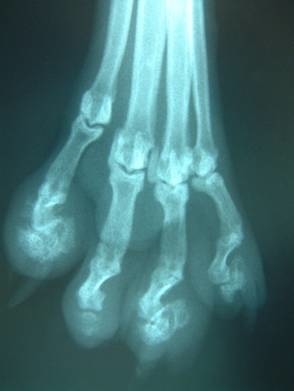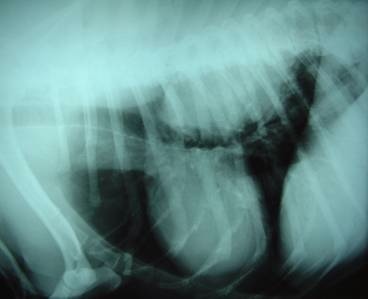+ General Considerations
- Primary lung tumors are rare in cats and account for < 1% of all tumors
- Mean age 11-12 years
- No breed predilection
- Sex predisposition: females
- Retroviruses may be involved in the pathogenesis of lung tumors in cats
+ Types of Lung Tumors
- Carcinomas are the most common primary lung tumor in cats
- Carcinomas are subclassified according to their location (i.e., bronchial, bronchoalveolar, and alveolar)
- Bronchial carcinomas are more common (76%) than either bronchoalveolar or alveolar carcinomas
- Bronchial ADC is the most common lung tumor in cats (66%-71%)
- Bronchoalveolar ADC, anaplastic carcinoma, and SCC account for 10%-15% of lung tumors
- 8% of primary pulmonary carcinomas are grade I, 23% grade II, and 69% of carcinomas are grade III
+ Metastasis
- 75% metastatic rate for primary lung tumors in cats
- Regional lymph node involvement in 29%-35% and distant metastasis in 46%-58%
- Distant metastatic sites include pleural cavity in 65% and extrathoracic sites in 35%
- Metastasis to multiple digits presenting as swelling of ≥ 1 toes and lameness without respiratory signs is a common primary complaint
- Weight-bearing digits and 3rd phalanx are most commonly affected
- Amputation is not palliative due development of further digit lesions and progressive non-respiratory disease

CLINICAL FEATURES
+ Clinical Signs
- Non-productive coughing, exercise intolerance, and other respiratory signs (i.e., dyspnea and tachypnea)
- Systemic signs include lethargy and weight loss
- Peracute presentation for hemothorax, pneumothorax, or malignant pleural effusion is uncommon
+ Paraneoplastic Syndromes
- Hypertrophic osteopathy has been reported in cats and dogs
- Paraneoplastic leukocytosis (which resolved following lung lobectomy) has been reported in 1 dog
- Hypercalcemia of malignancy has been reported in cats and dog
DIAGNOSIS
+ Thoracic Radiographs
- Lung tumors appear as a well-demarcated and spherical solitary ± cavitary mass in dogs
- Caudal lung lobes are most commonly affected
- Multiple masses may be present in dogs with primary pulmonary LSA, malignant histiocytosis, and lymphomatoid granulomatosis
- Diffuse lesions are present in up to 37% dogs with primary lung tumors
- Uncommon findings: multiple or miliary lesions, hilar lymphadenopathy, and pleural effusion

+ Advanced Imaging
- CT and MRI provide more accurate information on staging for resectability and detection of occult metastasis and hilar lymph node enlargement
+ Bronchoscopy
- Indications: brush cytology of centrally located lesions extending into the bronchus
- Trans-tracheal wash and bronchoalveolar lavage can be performed but are usually only diagnostic in diffuse LSA
+ Other Diagnostic Tests
- Thoracocentesis if pleural effusion
- Trans-thoracic FNA for larger lesions with a peripheral location, but larger tumors often have a necrotic centre resulting in a false-negative result
- Trans-thoracic FNA has an 80% accuracy rate, but is associated with 12% mortality rate in cats and dogs
- However, cytologic or histopathologic diagnosis is usually not required as results will not change treatment options (i.e., lung lobectomy)
Treatment
+ Surgical Management
- Lateral thoracotomy (4th-6th intercostal) for small to medium-sized lung tumors and hilar lymph node biopsy
- Median sternotomy for large tumors and inspection of other lung lobes, but lymph node biopsy is more difficult
- Lymph node aspirate or biopsy is recommended as neoplastic infiltration may not be clinically apparent
- Partial lobectomy can be performed for peripheral tumors, but complete lung lobectomy preferred
- Lobectomy can be performed with either stapling equipment or individual ligatures

+ Chemotherapy
- Systemic chemotherapy may offer some benefit
- Intracavitary chemotherapy ± sclerosing agents (i.e., talc or tetracycline) have been used for malignant effusions
- Inhalant chemotherapy using paclitaxel or doxorubicin has been investigated in dogs with primary and metastatic lung tumors:
- Responses in sarcomas but not carcinomas to doxorubicin
- Responses in both sarcomas and carcinomas with paclitaxel
- Response rate 27% (6/22) with 22.5% PR (5/22) and 4.5% CR (1/22)
- Intermittent and non-productive cough for 1-10 days in 50% dogs following inhalant doxorubicin
- Allergic reactions common following paclitaxel administration
PROGNOSIS
+ General Considerations
MST 115 days for cats with death or euthanasia due to metastatic disease
+ Clinical Stage or Lymph Node Involvement
- Cats with lymph node metastases or distant metastatic disease have a significantly worse survival time:
- MST for tumors without lymph node involvement: 412 days
- MST for tumors with lymph node involvement: 73 days
- MST for cats with metastatic lesions in digits: 67 days
+ Tumor Grade
- Degree of tumor differentiation only prognostic factor in cats
- 8% of primary pulmonary carcinomas are grade I, 23% grade II, and 69% of carcinomas are grade III
- Cats with well-differentiated tumors have a better prognosis than undifferentiated carcinomas
- MST for well-differentiated carcinoma: 23 months
- MST for undifferentiated carcinoma: 2.5 months
LUNG TUMORS
| T0 | No evidence of neoplasia |
| T1 | Solitary lung tumor surrounded by lung or visceral pleura - Primary Tumor |
| T2 | Multiple lung tumors of various sizes |
| T3 | Lung tumor invading adjacent tissue |
| N0 | No evidence of lymph node involvement |
| N1 | Bronchial lymph node involvement - Node |
| M0 | No evidence of metastasis |
| M1 | Evidence of distant metastasis with site specified - Metastasis |
| N2 | Distant lymph node involvement |


